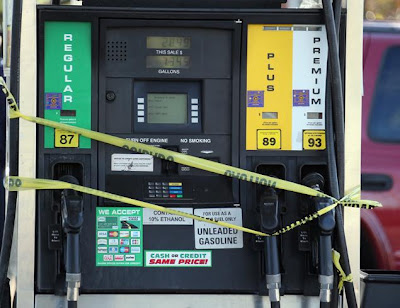By now you've probably heard the news, gas will be rationed in NYC and on Long Island effective 6am EST tomorrow. If your license plate ends in an odd number, you can buy gas (if you can find it) on odd numbered days, and those with even numbered license plates can make a purchase on even numbered days.
It's been over a week since Sandy ravaged the region, so what is the cause for the rationing? There are a few reasons: Many gas stations are still without power, and/or have other repair issues to take care of as a result of Sandy. Those who do have power and have been able to re-open can't get fuel brought in from distributors in the region.
A closed gas pump in the NYC Area (Getty Images)
The main culprit with the latter issue is that a key terminal, the Bayway Refinery in Linden, NJ, was badly damaged by salt water flooding. That facility, which typically processes 238,000 barrels of oil per day, is still out of service. Phillips 66, its parent company, estimates that the facility will not come back on line for 2-3 weeks. Once it does come back on line, it will take awhile to get the fuel flowing at normal levels as well.
New York Mayor Michael Bloomberg issued the "emergency order" today which instituted the rationing plan effective tomorrow morning. He said that the plan was an essential stop-gap until refineries and other distribution channels are fully restored. He said the order will remain in effect "until further notice".
While fuel rationing is certainly undesired and a major inconvenience, there is another situation unfolding in the region that could prove to be downright dangerous: a hospital shortage.
Thats right, more than one week after Sandy, some of the largest hospitals in lower Manhattan remain out of service, including NYU's Langone Medical Center, Bellevue Hospital, and the Manhattan Veteran's Affairs Medical Center.
National Guard Troops Assist with Evacuation of Bellevue Hospital (AP Photo)
Most of the hospitals were evacuated on the night that Sandy struck or the following day, as power generators either failed to start due to flooding, or the facilities ran out of fuel to supply them (or a combination of both). Hundreds of patients remain at other facilities across the region to this day, while others have been released early and sent home to recover.
The basement of Bellevue was inundated with about 17 million gallons of salt water, resulting in damage to everything from power panels to fuel and water pumps, according to city officials.
The closure of Bellevue was a particularly rough blow to Lower Manhattan, as it is the only level one trauma center in the area. Officials don't have an estimate as to when the facility will re-open. In the meantime, serious trama patients are being transported to facilities on the Upper East and Upper West sides of the city.
Crews Set Up Outside NYU's Langone Medical Center (AP Photo)
At NYU's Langone Medical Center (shown above on the night that Sandy impacted the region), engineers and operations folks thought they would be able to stay a step ahead of the storm.
After Hurricane Irene struck last year, the facility spent "several million dollars" protecting its backup power system from flooding. They moved the generators to the roof and built a flood resistant chamber to house the pumps that supply fuel from a sealed underground tank. One key vulnerability remained, however, in that several major power circuits were still left behind in the basement, which flooded in a similar fashion as Bellevue.
Ironically, NYU was in the process of constructing its own power generation facility at the time this took place. When the facility is complete, all key circuits will be housed in higher floors of the hospital. They estimate construction will be finished sometime in 2014. In the meantime, a hard estimate as to the re-opening date at NYU has not been provided.
The longer these facilities are closed, the more worrisome the situation becomes. One major fear is that should some local emergency or disaster occur, there won't be enough capacity at other hospitals to handle the additional load.
This is certainly an unprecedented situation in the region, which is what we feared from the beginning. Many emergency preparedness lessons will be learned from this event, hopefully well before the next one takes place somewhere else.
For more information from 'The Original Weather Blog', including shorter, more frequent posts during rapidly changing weather events, please be sure to follow Rob on facebook and twitter:
If you are in need of highly customized, site specific weather forecasts and/or storm warnings for your business, school or event, be sure visit my professional webpage at WeatherGuidance.com.






1 comment:
I remembered the terrible news 2 years back, and I never really forgot them and the problems they've bought. I've heard that hurricanes the caliber of Sandy are becoming the new norm. This should be an eye opener for all sectors to always be prepared. Emergency services with a 24 hour max-reaction time is one proactive way that I could think of to combat these problems, when they arise. Anyway, I hope we never get hit by another one this year. Kenny @ ApacheOilCompany.com
Post a Comment